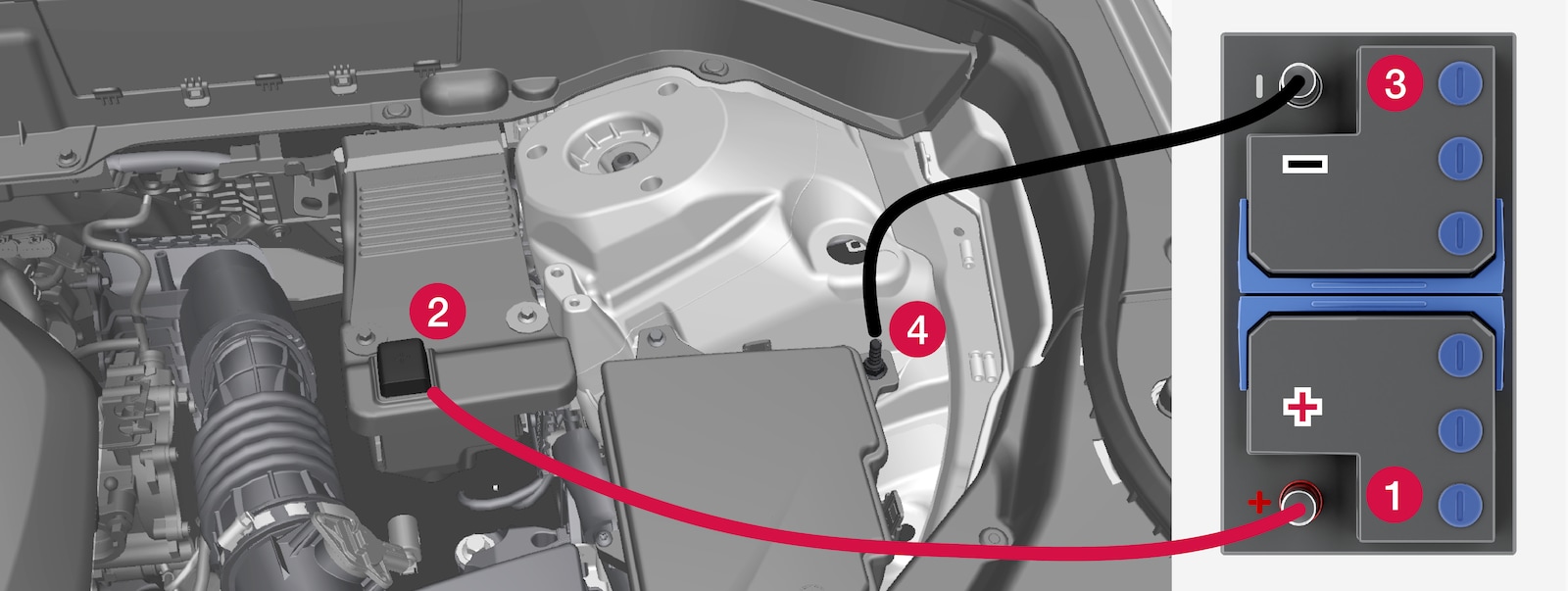Jump starting using another battery
If the start battery is discharged, current from another battery can be used to start the vehicle.
Jump-starting requires access to another vehicle's 12 V battery and jumper cables.
Important
In mild hybrid vehicles, a discharged start battery can be caused by an overloaded fuse that is preventing charging. If the fuse has blown, 12 V battery fuse failure Service required will be displayed in the instrument panel. Volvo recommends contacting an authorized Volvo workshop.

To avoid short circuits or other damage, the following steps are recommended when jump starting the battery using another battery:
Important
Important
Remove the jumper cables in the reverse order ‒ first the black cables and then the red cables.
Make sure that none of the clamps of the black jumper cables come into contact with the vehicle's positive charging point, the assisting vehicle's battery's positive terminal, or either of the red jumper cable's connected clamps.
Warning
Mild hybrid vehicles have components that work with 48 V voltage, which can be dangerous if handled incorrectly. Do not touch components that are not clearly described in the Owner's Manual.
- Never use a 48 V support battery to jump-start the vehicle.
- External electrical equipment may not under any circumstance be connected to the 48 V battery.
- Only a workshop may replace or perform service on the 48 V battery – an authorized Volvo workshop is recommended.
Warning
Warning
- Batteries generate hydrogen gas, which is flammable and explosive.
- Do not connect the jumper cable to any part of the fuel system or to any moving parts. Avoid touching hot manifolds.
- Battery fluid contains sulfuric acid. Do not allow battery fluid to contact eyes, skin, fabrics or painted surfaces.
- If contact occurs, flush the affected area immediately with water. Obtain medical help immediately if eyes are affected.
- Never expose the battery to open flame or electric spark. Do not smoke near the battery. Failure to follow the instructions for jump starting can lead to injury.
Note
If the starter battery has such a low charge level that the vehicle does not have normal electrical functions and the engine must then be jump-started with an external battery or a battery charger, the Start/Stop function may remain activated. If the Start/Stop function shortly thereafter auto-stops the engine, there is a huge risk that auto-start of the engine will fail since the battery had not had time to recharge sufficiently.
If the vehicle has been jump-started or if there has not been enough time for the battery to be charged with a battery charger, the Start/Stop function should be temporarily deactivated until the battery has been recharged sufficiently. At an ambient temperature of about +15 °C (about 60 °F), the battery must be charged by the vehicle for at least 1 hour. At lower ambient temperatures, the charging time can increase to 3-4 hours. The recommendation is to charge the battery with an external battery charger, if possible.